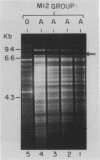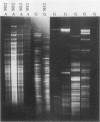Abstract
Human isolates of Lancefield group G streptococci harbor sequences homologous with the structural gene (emm) encoding M protein, a major virulence factor in Streptococcus pyogenes (a group A Streptococcus species). We used DNA-DNA hybridization, restriction endonuclease chromosomal profiling, and multilocus enzyme electrophoresis to examine genetic relationships between group A and group G streptococcal strains expressing homologous serologic type 12 M (M12) protein. All M12 group A strains studied had very similar restriction endonuclease genomic profiles and multilocus enzyme genotypes. In contrast, the restriction enzyme genomic profile and multilocus enzyme genotype of the M12 group G strain CS140 were strikingly different from those characterizing the M12 group A organisms. DNA-DNA hybridization studies revealed, on average, 57% genomic similarity between the M12 group A and group G strains. Taken together, our data demonstrate that a gene encoding M12 protein occurs in two highly divergent chromosomal backgrounds, a result suggesting that an episode of horizontal gene transfer and recombination has occurred between two streptococcal lineages.
Full text
PDF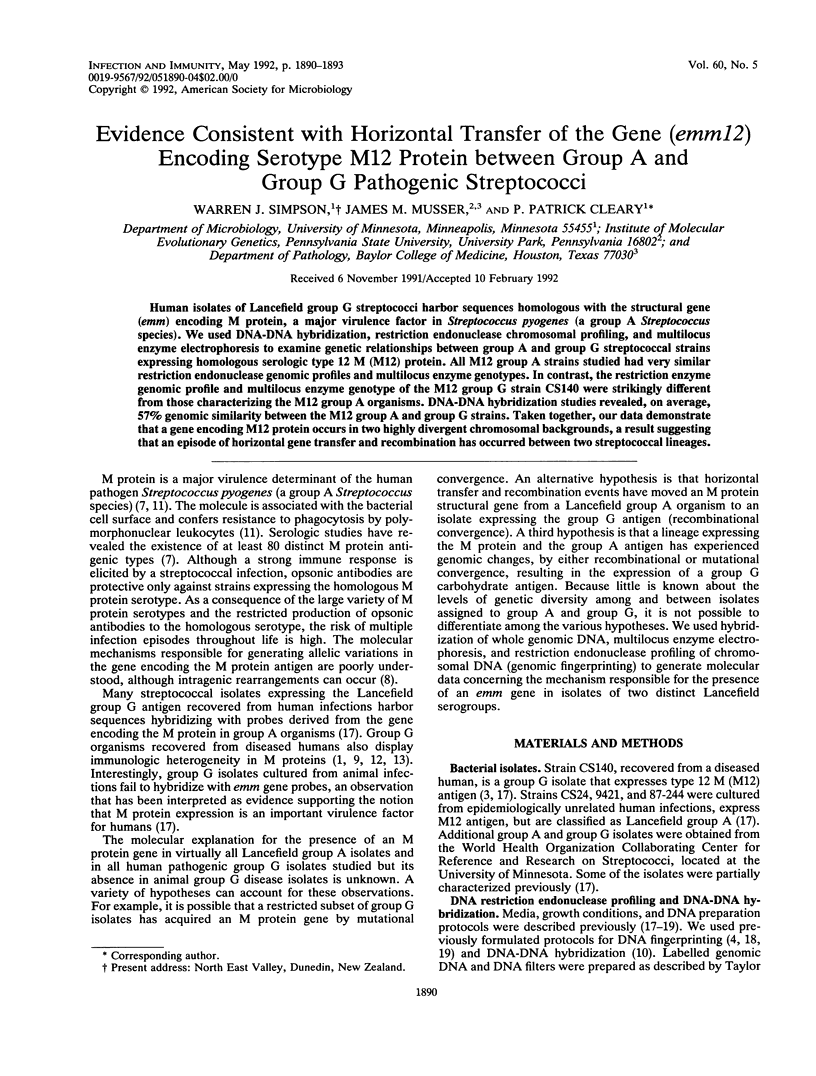
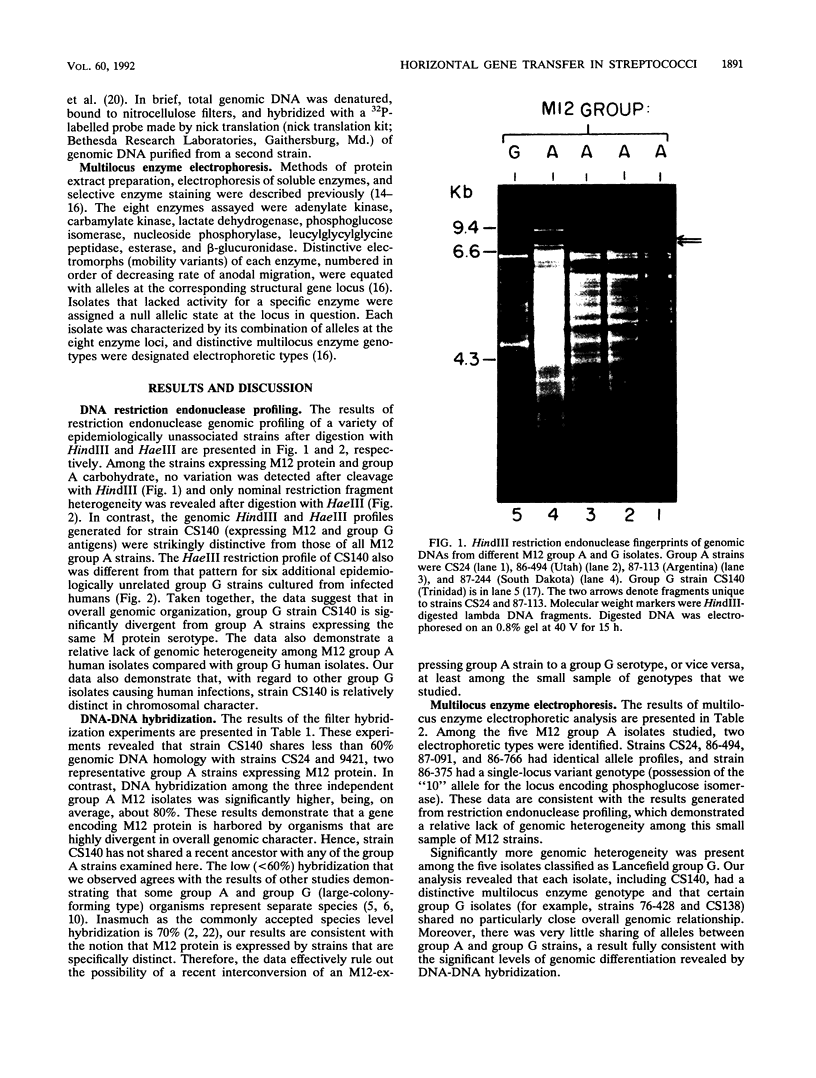
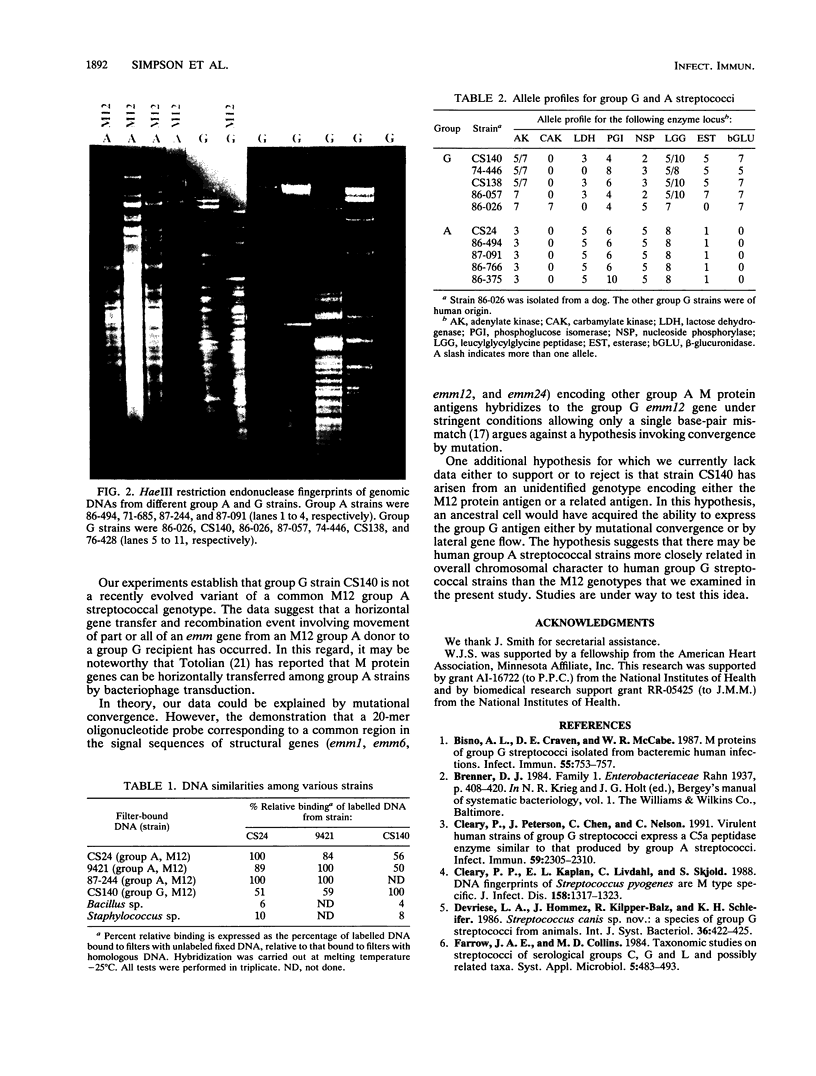
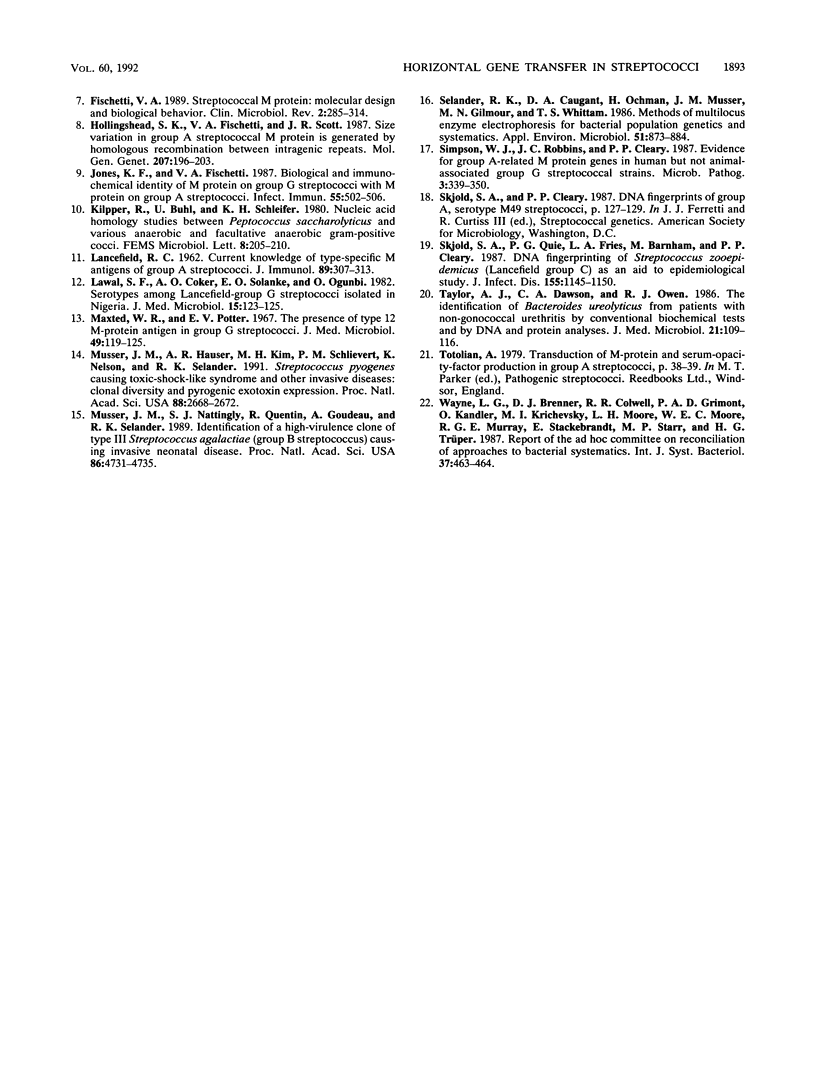
Images in this article
Selected References
These references are in PubMed. This may not be the complete list of references from this article.
- Bisno A. L., Craven D. E., McCabe W. R. M proteins of group G streptococci isolated from bacteremic human infections. Infect Immun. 1987 Mar;55(3):753–757. doi: 10.1128/iai.55.3.753-757.1987. [DOI] [PMC free article] [PubMed] [Google Scholar]
- Cleary P. P., Kaplan E. L., Livdahl C., Skjold S. DNA fingerprints of Streptococcus pyogenes are M type specific. J Infect Dis. 1988 Dec;158(6):1317–1323. doi: 10.1093/infdis/158.6.1317. [DOI] [PubMed] [Google Scholar]
- Cleary P. P., Peterson J., Chen C., Nelson C. Virulent human strains of group G streptococci express a C5a peptidase enzyme similar to that produced by group A streptococci. Infect Immun. 1991 Jul;59(7):2305–2310. doi: 10.1128/iai.59.7.2305-2310.1991. [DOI] [PMC free article] [PubMed] [Google Scholar]
- Fischetti V. A. Streptococcal M protein: molecular design and biological behavior. Clin Microbiol Rev. 1989 Jul;2(3):285–314. doi: 10.1128/cmr.2.3.285. [DOI] [PMC free article] [PubMed] [Google Scholar]
- Hollingshead S. K., Fischetti V. A., Scott J. R. Size variation in group A streptococcal M protein is generated by homologous recombination between intragenic repeats. Mol Gen Genet. 1987 May;207(2-3):196–203. doi: 10.1007/BF00331578. [DOI] [PubMed] [Google Scholar]
- Jones K. F., Fischetti V. A. Biological and immunochemical identity of M protein on group G streptococci with M protein on group A streptococci. Infect Immun. 1987 Mar;55(3):502–506. doi: 10.1128/iai.55.3.502-506.1987. [DOI] [PMC free article] [PubMed] [Google Scholar]
- LANCEFIELD R. C. Current knowledge of type-specific M antigens of group A streptococci. J Immunol. 1962 Sep;89:307–313. [PubMed] [Google Scholar]
- Lawal S. F., Coker A. O., Solanke E. O., Ogunbi O. Serotypes among Lancefield-group G streptococci isolated in Nigeria. J Med Microbiol. 1982 Feb;15(1):123–125. doi: 10.1099/00222615-15-1-123. [DOI] [PubMed] [Google Scholar]
- Maxted W. R., Potter E. V. The presence of type 12 M-protein antigen in group G streptococci. J Gen Microbiol. 1967 Oct;49(1):119–125. doi: 10.1099/00221287-49-1-119. [DOI] [PubMed] [Google Scholar]
- Musser J. M., Hauser A. R., Kim M. H., Schlievert P. M., Nelson K., Selander R. K. Streptococcus pyogenes causing toxic-shock-like syndrome and other invasive diseases: clonal diversity and pyrogenic exotoxin expression. Proc Natl Acad Sci U S A. 1991 Apr 1;88(7):2668–2672. doi: 10.1073/pnas.88.7.2668. [DOI] [PMC free article] [PubMed] [Google Scholar]
- Musser J. M., Mattingly S. J., Quentin R., Goudeau A., Selander R. K. Identification of a high-virulence clone of type III Streptococcus agalactiae (group B Streptococcus) causing invasive neonatal disease. Proc Natl Acad Sci U S A. 1989 Jun;86(12):4731–4735. doi: 10.1073/pnas.86.12.4731. [DOI] [PMC free article] [PubMed] [Google Scholar]
- Selander R. K., Caugant D. A., Ochman H., Musser J. M., Gilmour M. N., Whittam T. S. Methods of multilocus enzyme electrophoresis for bacterial population genetics and systematics. Appl Environ Microbiol. 1986 May;51(5):873–884. doi: 10.1128/aem.51.5.873-884.1986. [DOI] [PMC free article] [PubMed] [Google Scholar]
- Simpson W. J., Robbins J. C., Cleary P. P. Evidence for group A-related M protein genes in human but not animal-associated group G streptococcal pathogens. Microb Pathog. 1987 Nov;3(5):339–350. doi: 10.1016/0882-4010(87)90004-0. [DOI] [PubMed] [Google Scholar]
- Skjold S. A., Quie P. G., Fries L. A., Barnham M., Cleary P. P. DNA fingerprinting of Streptococcus zooepidemicus (Lancefield group C) as an aid to epidemiological study. J Infect Dis. 1987 Jun;155(6):1145–1150. doi: 10.1093/infdis/155.6.1145. [DOI] [PubMed] [Google Scholar]
- Taylor A. J., Dawson C. A., Owen R. J. The identification of Bacteroides ureolyticus from patients with non-gonococcal urethritis by conventional biochemical tests and by DNA and protein analyses. J Med Microbiol. 1986 Mar;21(2):109–116. doi: 10.1099/00222615-21-2-109. [DOI] [PubMed] [Google Scholar]



